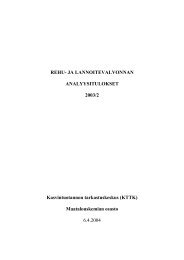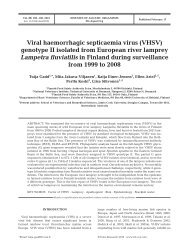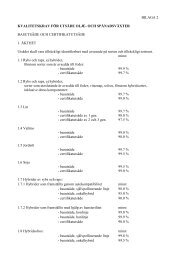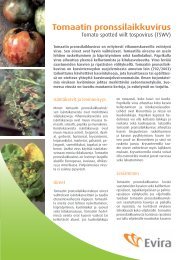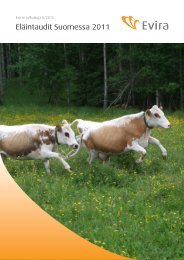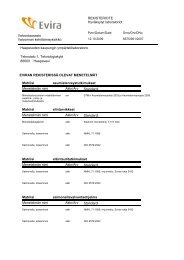Molecular characterization of endemic salmonella infections ... - Evira
Molecular characterization of endemic salmonella infections ... - Evira
Molecular characterization of endemic salmonella infections ... - Evira
You also want an ePaper? Increase the reach of your titles
YUMPU automatically turns print PDFs into web optimized ePapers that Google loves.
PFGE. PFGE has been used both for subdivision within serotype such as S. Brandenburg (Baquar<br />
et al 1994a), S. Berta (Ellis et al 1998), and S. Javiana (Lee et al 1998) and phage type such as S.<br />
Typhi (Nair et al 1994), and S. Enteritidis (Lukinmaa et al 1999).<br />
S. Agona does not carry IS200 (Gibert et al 1995) and is unlikely to be subdivided by ribotyping<br />
(Threlfall and Hampton, unpublished). However, PFGE proved useful in the analysis <strong>of</strong> an<br />
international outbreak caused by S. Agona contaminated snacks (Threlfall et al 1996). In<br />
investigating an outbreak <strong>of</strong> human salmonellosis caused by S. Infantis, PFGE typing results<br />
indicated a common source for the outbreak (Wegener and Baggesen 1996). In characterizing<br />
human and environmental isolates <strong>of</strong> S. Infantis, 35 distinct PFGE pr<strong>of</strong>iles were detected. None <strong>of</strong><br />
the environmental isolates shared the pr<strong>of</strong>ile common to all the human isolates, therefore the<br />
source for the human outbreak could not be identified (Murakami et al 1999). PFGE results<br />
indicated a spread <strong>of</strong> a single strain <strong>of</strong> S. Infantis among humans in Argentina (Merino et al 2003).<br />
Moreover, PFGE proved to be very useful for subdivision <strong>of</strong> strains <strong>of</strong> S. Typhimurium definitive<br />
type (DT) 12, 193 and 104 in an outbreak. In particular, the PFGE pr<strong>of</strong>iles <strong>of</strong> DT12 and DT193<br />
were identical, whereas DT104 yielded a clearly different pr<strong>of</strong>ile (Corbett-Feeney and Ni Riain<br />
1998). In a study by Kariuki et al (1999), isolates <strong>of</strong> 11 different phage types <strong>of</strong> S. Typhimurium<br />
were divided into eight PFGE clusters. No consistent pattern <strong>of</strong> association between the phage<br />
types <strong>of</strong> the isolates and a particular PFGE cluster was seen.<br />
A problem reported infrequently in some serovars such as S. Saintpaul, is the presence <strong>of</strong><br />
unspecific nuclease activity (Baggesen et al 1996). This phenomenon makes the preparation and<br />
analysis <strong>of</strong> PFGE pr<strong>of</strong>iles impossible. Recently, Liesegang and Tschäpe (2002) determined that<br />
the DNA is degraded during electrophoresis by Tris radicals in the running buffer. By adding<br />
thiourea to the Tris-containing buffer, the degradation <strong>of</strong> the DNA could be prevented.<br />
In a study <strong>of</strong> 110 S. enterica subspecies enterica isolates and 25 serotypes genotyped by<br />
multilocus sequence typing (MLST), PFGE and amplified fragment length polymorphism (AFLP),<br />
PFGE was found to be as discriminatory as AFLP. Moreover, PFGE fingerprints were easier to<br />
interpret and reproduce, in addition to being less time-consuming to analyse. Similarly, it is easier<br />
to compare PFGE pr<strong>of</strong>iles between laboratories, and therefore PGFE is the preferred molecular<br />
typing method for surveillance and outbreak investigations (Torpdahl et al 2005). In typing 85<br />
clinical isolates <strong>of</strong> S. Typhimurium, PFGE was superior to MLST, as MLST could reveal no<br />
differences between the nucleotides within the four selected genes in the analysed isolates (Fakhr<br />
et al 2005). However, for the typing <strong>of</strong> the highly homogenous S. Typhimurium DT104 in outbreak<br />
investigations, even PFGE is not discriminative enough (Murphy et al 2001).<br />
31



